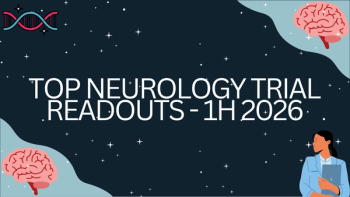
Neuro-News Roundup: NMOSD – Latest Literature and Expert Conversations
Get the latest news in neuromyelitis optica spectrum disorder, with data updates and expert insights, all in one place from the NeurologyLive team.
In recent weeks, the NeurologyLive team has conducted interviews and covered news of the latest updates in the clinical care of individuals with neuromyelitis optica spectrum disorder (NMSOD). With several new therapeutic additions to the physician’s treatment toolbox since 2019, the field has been experiencing an influx of additional interest, which in turn has incited a number of conversations about future advances.
To offer an update on those new developments in the literature and insight into the expert opinions about how they’re shaping the care paradigm in NMOSD, our team has compiled some of the biggest pieces of news and exciting exchanges with physicians into one place.
Click here for more coverage of the
EXPERT INSIGHTS
Melanie Truong-Le, DO, OD, neuro-ophthalmologist, Peter O’Donnell Jr. Brain Institute, UT Southwestern Medical Center, sat down with NeurologyLive to discuss the clinical application of new technology for NMOSD, as it relates to the treatment of optic neuritis. Truong-Le offered a unique perspective as a neuro-ophthalmologist, commenting on the use of optical coherence tomography (OCT), a noninvasive imaging technique using light rays to look at nerve fiber layer. She further discussed technological advances associated with aquaporin-4 antibody detection, as well as with the myelin oligodendrocyte glycoprotein antibody detection.
Bruce Cree, MD, PhD, MAS, FAAN, clinical research director, UCSF Multiple Sclerosis Center, and professor of clinical neurology, UCSF Weill Institute for Neurosciences, told NeurologyLive about his experiences with new NMOSD therapies and the effect that they’ve had on clinical care. Cree also expounded on the impact that the COVID-19 pandemic has had on getting information out to patients and physicians about these new agents since 2 of the 3—satralizumab and inebilizumab—entered the market during the pandemic’s height while the other—eculizumab—was only available for a short time prior to its inception.
Sean Pittock, MD, director, Center for Multiple Sclerosis and Autoimmune Neurology, Mayo Clinic, claims that the recent strides have been nothing short of an "amazing feat for the neurological community." Pittock also directs the Mayo Clinic Neuroimmunology Research Laboratory, and has focused on multidisciplinary, collaborative research in autoimmune disorders, autoimmune gastrointestinal dysmotility, and NMOSD. He sat down with NeurologyLive to provide thoughts on each approved therapy, the data that led to their approvals, and the most notable advancements made in recent years.
Brian G. Weinshenker, MD, professor of neurology, Mayo Clinic College of Medicine, told NeurologyLive that despite at one time not considering it an independent disease, researchers have uncovered more about the presentation and diagnosis of NMOSD and how it differentiates from other demyelinating diseases such as multiple sclerosis. Advances of homogenous populations for clinical trials and targeted FDA-approved treatments have entered the fold in just the past 2 years, although several questions surrounding disease progression and treatment optimization remain. Weinshenker discussed areas within the NMOSD space that have improved and others that need continued research.
LATEST LITERATURE
GFAP Represents Greatest Longitudinal Clinical Value Biomarker for NMOSD
In early July 2021, newly published data from Young-Min Lim, MD, PhD, Department of Neurology, Asan Medical Center, and colleagues suggested that glial fibrillary acidic protein (GFAP) might be the most appropriate longitudinal biomarker to monitor disease activity for patients with NMOSD. “These findings suggest that GFAP might be the most suitable of these serum markers to longitudinally monitor NMOSD, and warrant future confirming studies,” Lim et al wrote.1
Changes in serum biomarkers such as neurofilament light chain (NfL), GFAP, and GFAP/NFL in 64 patients (58 women) with antiaquaporin-4 antibody (AQP4) NMOSD were evaluated, with 133 total samples obtained at enrollment, after 6- to 12-months of follow-up, and at attacks. Of those, 62 patients did not develop new attacks during the main study period. Patients were then classified into 2 groups depending on the baseline status of having recent attacks. In the baseline-attack group (n = 14), and no-baseline-attack group (n = 48), serum levels of neurofilament light (NfL) and GFAP, but not the GFAP/NfL quotient, were modestly but significantly increased at follow-up. During this period, Expanded Disability Status Scale scores were constant (baseline vs follow-up: 3.3 [range, 2.0-4.0] vs 3.0 [range, 2.0-4.0]; P = .245).
To read more,
Anti-CD20 Therapy for MS and NMOSD Linked to Lower COVID-19 Antibody Response
Data published in early August 2021 suggest that despite observing a high SARS-CoV-2 seroconversion rate among patients with multiple sclerosis (MS) or NMOSD, those treated with an anti-CD20 therapy had a seroconversion rate 2 times as low as untreated patients or patients receiving a non-antiCD20 disease-modifying therapy (DMT).2
According to senior author Valerie Pourcher, MD, PhD, associate professor, Hôpital de la Pitié Salpêtrière, and colleagues, these findings, while heterogeneous in nature, warrant monitoring the long-term risk of reinfection and specific vaccination strategies for patients within these populations. Including blood samples of 119 patients (115 MS, 4 NMOSD; mean age, 43 years) diagnosed with COVID-19 between February 19, 2020, and February 26, 2021, the overall seroconversion rate was 80.6% (n = 96) within 5 months (standard deviation [SD], 3.4) after infection. Specific subanalysis showed that those on anti-CD20 therapies had lower anti-S IgG positivity (P <.001), lower anti-S IgG titer (P <.001), lower anti-S IgA positivity (P = .05), and a lower anti-N IgG positivity (P <.001) in comparison to other DMT groups. Notably, there were no observed differences on such outcomes between the other DMT subgroups.
To read more,
MOG-Ab Screening May Facilitate Diagnosis and Treatment of NMOSD
A review of 14 studies, conducted between 2012 and 2020, were published in Multiple Sclerosis and Related Disorders by Xindi Li, MD, China National Clinical Research Center for Neurological Diseases, Beijing Tiantan Hospital, Capital Medical University, and colleagues. They found that 9.3% of patients with NMOSD were MOG-Ab positive (95% CI, 7.9-10.8; I2 = 13.1%).3
When evaluating the occurrence of MOG-Ab in patients with AQP4-Ab seronegative NMOSD, 32.5% were positive (95% CI, 25.7-39.3; I2 = 45.8%). This data was found to be significantly influenced by differences between diagnostic criteria between 2006/2007 and 2015 (P = .002; R2 = 1), but relatively uninfluenced by study type (P = .90) and region (P = .96). When using only International Panel for NMO Diagnosis (IPND) 2015 NMOSD criteria, the subset of AQP4-Ab seronegative NMOSD patients with MOG-Abs reached up to 41.6% (95% CI, 35.1-48.2; I2 = 0.0%).
“In contrast with the 2006 NMO criteria, the term NMOSD was proposed in order to cover a wider clinical spectrum than previously accommodated by NMO criteria, notably adding MRI requirements including optic neuritis lesions extending over [one-half] the optic nerve length or involving optic chiasm, LETM lesions extending over three contiguous segments, and periependymal brain lesion,” Li et al wrote. “Consequently, only 49% of the panel-defined NMOSD were also diagnosed by 2006 Wingerchuk NMO criteria, while 97% were correctly identified by the IPND 2015 NMOSD criteria in a study of pediatric patients.”
To read more,
Distinct MRI Features Identified Between AQP4-NMOSD and MOG-Antibody Disease
A systematic review and meta-analysis identified distinct MRI features between patients with MOG-antibody disease (MOG-AD) and AQP4-NMOSD that may guide clinicians in the choice of antibody testing and address the differential diagnosis. Led by Tiziana Carandini, MD, neurologist, Fondazione IRCCS, Granda Ospedale Maggiore Policlinico, and colleagues, 14 case-series studies (n = 1028) were included in the review, comparing MRI lesion patterns in optic nerve (ON), brain, and spinal cord (SC) between patients with MOG-AD and AQP4-NMOSD. MRI data concerning contrast-enhancement patterns were excluded, as well as those radiological features linked to an appropriate participants’ follow-up. "An early differentiation of MOG from AQP4 has important implications for prognostic and therapeutic purposes. A standardization of CNS sites terminology is mandatory to obtain a more comprehensive differentiation of topographical patterns of MRI lesions of MOG and AQP4 in future studies,” Caradini et al wrote.4
Comparisons between groups showed that retrobulbar lesions predominated in patients with MOG-AD (OR, 5.67 [95% CI, 2.11-15.24]; P = .00006), with moderate evidence of heterogeneity (I2 = 45%). Conversely, results demonstrated a slight predominance of both canalicular (OR, 0.42 [95% CI, 0.18-0.98] P = .05) and intracranial lesions (OR, 0.30 [95% CI, 0.11-0.84]; P = .02) for patients with AQP4-NMOSD, with no heterogeneity for both outcomes (I2 = 0%).
To read more,
REFERENCES
1. Kim H, Lee EJ, Kim S. Longitudinal follow-up of serum biomarkers in patients with neuromyelitis optica spectrum disorder. Multiple Sclerosis Journal. Published online July 2, 2021. doi:10.1177/13524585211024978
2.Louapre C, Ibrahim M, Maillart E, et al. Anti-CD20 therapies decrease humoral immune response to SARS-CoV-2 in patients with multiple sclerosis or neuromyelitis optica spectrum disorders. J Neurol Neurosurg Psychiatry. Published online August 2, 2021. doi:10.1136/jnnp-2021-326904
3. Li X, Zhang C, Jia D. The occurrence of myelin oligodendrocyte glycoprotein antibodies in aquaporin-4-antibody seronegative Neuromyelitis Optica Spectrum Disorder: A systematic review and meta-analysis. Mult Scler Relat Disord. Published online May 27, 2021. doi:10.1016/j.msard.2021.103030
4. Carandini T, Sacchi L, Bovis F, et al. Distinct patterns of MRI lesions in MOG antibody disease and AQP4 NMOSD: a systematic review and meta-analysis. Mult Scler Relat Disord. Published online June 30, 2021. doi:10.1016/j.msard.2021.103118
Newsletter
Keep your finger on the pulse of neurology—subscribe to NeurologyLive for expert interviews, new data, and breakthrough treatment updates.




























